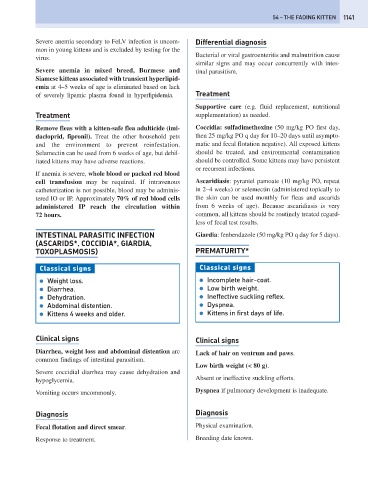Page 1149 - Problem-Based Feline Medicine
P. 1149
54 – THE FADING KITTEN 1141
Severe anemia secondary to FeLV infection is uncom- Differential diagnosis
mon in young kittens and is excluded by testing for the
Bacterial or viral gastroenteritis and malnutrition cause
virus.
similar signs and may occur concurrently with intes-
Severe anemia in mixed breed, Burmese and tinal parasitism.
Siamese kittens associated with transient hyperlipid-
emia at 4–5 weeks of age is eliminated based on lack
of severely lipemic plasma found in hyperlipidemia. Treatment
Supportive care (e.g. fluid replacement, nutritional
Treatment supplementation) as needed.
Remove fleas with a kitten-safe flea adulticide (imi- Coccidia: sulfadimethoxine (50 mg/kg PO first day,
dacloprid, fipronil). Treat the other household pets then 25 mg/kg PO q day for 10–20 days until asympto-
and the environment to prevent reinfestation. matic and fecal flotation negative). All exposed kittens
Selamectin can be used from 6 weeks of age, but debil- should be treated, and environmental contamination
itated kittens may have adverse reactions. should be controlled. Some kittens may have persistent
or recurrent infections.
If anemia is severe, whole blood or packed red blood
cell transfusion may be required. If intravenous Ascaridiasis: pyrantel pamoate (10 mg/kg PO, repeat
catheterization is not possible, blood may be adminis- in 2–4 weeks) or selemectin (administered topically to
tered IO or IP. Approximately 70% of red blood cells the skin can be used monthly for fleas and ascarids
administered IP reach the circulation within from 6 weeks of age). Because ascaridiasis is very
72 hours. common, all kittens should be routinely treated regard-
less of fecal test results.
INTESTINAL PARASITIC INFECTION Giardia: fenbendazole (50 mg/kg PO q day for 5 days).
(ASCARIDS*, COCCIDIA*, GIARDIA,
TOXOPLASMOSIS) PREMATURITY*
Classical signs Classical signs
● Weight loss. ● Incomplete hair-coat.
● Diarrhea. ● Low birth weight.
● Dehydration. ● Ineffective suckling reflex.
● Abdominal distention. ● Dyspnea.
● Kittens 4 weeks and older. ● Kittens in first days of life.
Clinical signs Clinical signs
Diarrhea, weight loss and abdominal distention are Lack of hair on ventrum and paws.
common findings of intestinal parasitism.
Low birth weight (< 80 g).
Severe coccidial diarrhea may cause dehydration and
Absent or ineffective suckling efforts.
hypoglycemia.
Dyspnea if pulmonary development is inadequate.
Vomiting occurs uncommonly.
Diagnosis Diagnosis
Fecal flotation and direct smear. Physical examination.
Response to treatment. Breeding date known.

